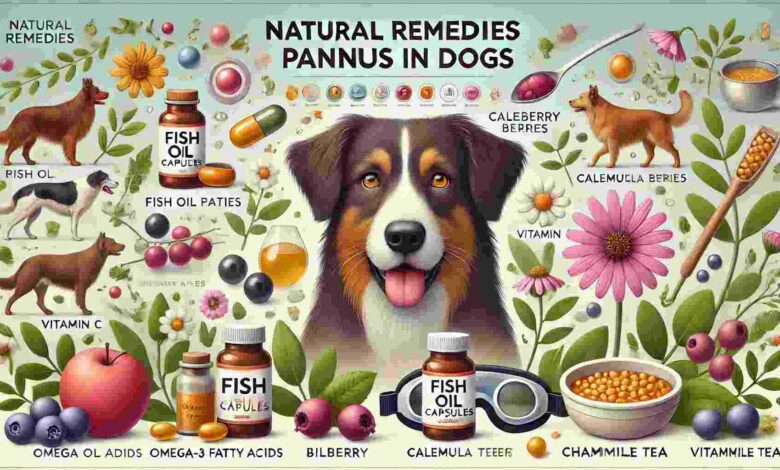Natural Remedies for Pannus in Dogs: Effective Holistic Treatments
Holistic Approaches to Manage Pannus and Enhance Your Dog's Eye Health

Pannus, scientifically known as chronic superficial keratitis, is a progressive inflammatory eye disease that can significantly affect a dog’s vision and overall quality of life. This condition is characterized by the development of a reddish-brown tissue growth on the cornea, leading to cloudiness and vision impairment. Many pet owners are turning to natural remedies for pannus in dogs as a holistic approach to managing this condition, seeking to reduce symptoms and enhance their furry friends’ quality of life. This comprehensive guide will delve into various natural remedies, their benefits, and practical applications.
Understanding Pannus in Dogs
What Is Pannus?
Pannus occurs when the dog’s immune system mistakenly attacks its own eye tissue, particularly the cornea. This autoimmune reaction leads to inflammation and abnormal tissue growth. While pannus can affect any dog, it is more prevalent in certain breeds, including German Shepherds, Belgian Tervurens, and Greyhounds.
Symptoms of Pannus
Identifying the symptoms of pannus early can aid in effective management. Common signs include:
- Redness and Inflammation: Affected eyes may appear red and inflamed due to increased blood flow.
- Corneal Changes: The development of a pigmented, fleshy growth on the cornea, often resembling a third eyelid.
- Cloudiness: The eye may appear cloudy or hazy, indicating tissue damage.
- Light Sensitivity: Dogs may squint or avoid bright light, showing signs of discomfort.
- Vision Impairment: As the condition progresses, dogs may struggle to see clearly, affecting their daily activities.
Recognizing these symptoms early can help in seeking appropriate treatment and adopting natural remedies for pannus in dogs.
Causes and Risk Factors
Genetic Predisposition
Certain dog breeds are genetically predisposed to develop pannus. Breeds such as German Shepherds, Belgian Malinois, and Greyhounds show a higher incidence of this condition. Understanding the genetic risks can help owners monitor their pets closely for early signs.
Environmental Factors
Environmental factors can exacerbate pannus. Dogs living in high UV exposure areas or at high altitudes are at increased risk. Pollution, smoke, and irritants can also contribute to the condition. Minimizing exposure to these factors can significantly impact the progression of pannus.
Why Consider Natural Remedies?
Natural remedies for pannus in dogs provide a holistic approach that may help alleviate symptoms without the side effects often associated with conventional medications. Many pet owners prefer these methods as they align with a more natural lifestyle and focus on overall well-being. However, it’s crucial to consult with a veterinarian before introducing new treatments to ensure they complement existing care.
Effective Natural Remedies for Pannus in Dogs
1. Omega-3 Fatty Acids
Benefits of Omega-3s
Omega-3 fatty acids are renowned for their anti-inflammatory properties. They help reduce inflammation in the body, making them beneficial for dogs with pannus. Omega-3s can enhance the immune response and support overall eye health, which is crucial for managing pannus effectively.
How to Supplement Omega-3s
You can introduce Omega-3 fatty acids into your dog’s diet through fish oil supplements or by incorporating fatty fish like salmon and sardines into their meals. It’s advisable to choose high-quality fish oil products, free from contaminants. The recommended dosage will depend on your dog’s weight and should be discussed with your veterinarian.
2. Bilberry Extract
How Bilberry Supports Eye Health
Bilberry is rich in antioxidants, particularly anthocyanins, which are known to support eye health. This natural remedy enhances blood circulation in the eye area, reduces inflammation, and strengthens the capillaries, which can be beneficial for dogs suffering from pannus.
Dosage and Administration
Bilberry extract is available in capsules or powder form. The appropriate dosage will depend on your dog’s weight and should always be determined in consultation with a veterinarian. Adding bilberry to your dog’s diet can help enhance their overall eye health.
3. Vitamin C
Benefits of Vitamin C for Pannus
Vitamin C acts as a potent antioxidant that supports the immune system and reduces inflammation. For dogs with pannus, Vitamin C can help strengthen eye tissues and potentially slow the progression of the disease.
Safe Dosage
It’s essential to provide Vitamin C in moderation. Consult your veterinarian for the proper dosage based on your dog’s size and health condition. Too much Vitamin C can lead to gastrointestinal upset, so always adhere to professional guidance.
4. Calendula Eye Drops
Healing Properties of Calendula
Calendula, known for its anti-inflammatory and healing properties, can provide relief for dogs with pannus. This natural remedy can soothe irritation, reduce redness, and promote healing of inflamed tissues in the eyes.
How to Use Calendula Eye Drops
Look for calendula-based eye drops specifically formulated for dogs. Follow the manufacturer’s instructions for application, typically involving a few drops in the affected eye(s) two to three times a day.
5. Eyebright
How Eyebright Supports Eye Health
Eyebright is a traditional herb known for its effectiveness in treating eye conditions. It has anti-inflammatory properties that can help reduce redness and soothe irritation caused by pannus.
Dosage and Application
Eyebright is commonly available in liquid form or as a tincture. You can add it to your dog’s water or food, but ensure you discuss the correct dosage with your veterinarian to avoid any adverse effects.
6. Chamomile Compress
Benefits of Chamomile for Inflammation
Chamomile is well-known for its calming and anti-inflammatory properties. Using a chamomile compress can help soothe irritated eyes and provide relief from the discomfort associated with pannus.
How to Make a Chamomile Compress
To create a chamomile compress, steep chamomile tea in hot water and allow it to cool. Soak a clean cloth in the tea and gently press it against your dog’s closed eye for a few minutes. This process can be done once or twice daily to alleviate symptoms.
7. UV-Protective Dog Goggles
Reducing UV Exposure
To prevent exacerbation of pannus symptoms, UV-protective dog goggles can be an excellent preventive measure. These specially designed goggles block harmful UV rays and protect your dog’s eyes from bright sunlight.
Choosing the Right Goggles
Select goggles that fit your dog comfortably and securely. It’s crucial to ensure that the goggles provide adequate UV protection. Gradually acclimate your dog to wearing goggles to make the experience more comfortable.
8. Dietary Changes
Anti-Inflammatory Diet
An anti-inflammatory diet can significantly benefit dogs with pannus. Foods rich in antioxidants, such as blueberries, carrots, sweet potatoes, and green leafy vegetables, can help support your dog’s immune system and overall health.
Avoid Allergens
If your dog has allergies, it’s essential to identify and avoid allergenic foods that may contribute to inflammation. Collaborate with your veterinarian to create a tailored diet plan that addresses your dog’s specific needs.
Additional Tips for Managing Pannus Naturally
Regular Eye Examinations
Routine eye examinations by a veterinarian are vital for dogs with pannus. Regular check-ups allow for early detection of changes and timely adjustments to the treatment plan.
Clean Environment
Maintaining a clean environment can reduce irritants such as dust, pollen, and smoke that may aggravate pannus symptoms. Regularly clean your dog’s bedding, toys, and living area to minimize exposure to allergens.
Stress Reduction
Stress can negatively impact your dog’s immune system, making them more susceptible to inflammation. Engaging your dog in regular physical activities, providing mental stimulation, and ensuring a calm environment can help reduce stress levels.
When to Seek Veterinary Intervention
Signs of Progression
If you notice any worsening of your dog’s condition despite using natural remedies, it’s crucial to consult your veterinarian. Signs of progression may include sudden changes in vision, excessive tearing, or a significant increase in inflammation.
Combining Natural Remedies with Conventional Treatment
In some cases, a combination of natural and conventional treatments may yield the best results. While natural remedies can be effective, conventional medications like topical steroids may be necessary to control severe inflammation. Work closely with your veterinarian to create a comprehensive treatment plan.
Monitoring and Adjusting Natural Remedies
Each dog responds differently to natural remedies for pannus. It’s essential to monitor your dog’s progress and consult your veterinarian for any necessary adjustments. Keeping track of your dog’s symptoms and any changes can help guide treatment decisions.
Documenting Changes
Maintaining a journal of your dog’s symptoms and remedies used can be beneficial. Note any improvements or side effects experienced with each remedy, which can help you and your veterinarian make informed decisions about ongoing treatment.
FAQs About Natural Remedies for Pannus in Dogs
Can I Treat My Dog’s Pannus Without Steroids?
While natural remedies can be beneficial for managing symptoms, many dogs may require steroids for effective control of inflammation. Always consult your veterinarian before discontinuing any prescribed medications.
How Long Do Natural Remedies Take to Show Results?
The effectiveness of natural remedies can vary from dog to dog. Most pet owners may start to see improvements within a few weeks, but some dogs may require a more extended period for noticeable results.
Are There Any Side Effects of Using Natural Remedies?
Generally, natural remedies have fewer side effects than pharmaceuticals. However, it’s crucial to use them in moderation and consult your veterinarian to avoid potential adverse reactions.
Can Pannus Be Prevented?
While complete prevention of pannus may not be possible, minimizing UV exposure and maintaining a healthy lifestyle can help reduce the risk of developing this condition.
What If My Dog’s Condition Worsens?
If you notice any signs that your dog’s condition is worsening, such as increased redness, swelling, or any change in vision, it’s crucial to seek veterinary attention immediately. Delaying treatment can lead to further complications and damage.
Conclusion: Enhancing Eye Health with Natural Remedies for Pannus in Dogs
Managing pannus in dogs can be challenging, but using natural remedies provides a holistic approach to support your dog’s eye health. By incorporating supplements like Omega-3 fatty acids, bilberry extract, and Vitamin C, alongside topical treatments such as calendula eye drops and chamomile compresses, you can help alleviate symptoms and improve your dog’s quality of life.
Regular veterinary check-ups and a clean, stress-free environment are essential in managing this condition effectively. While natural remedies can significantly contribute to eye health, they should complement veterinary care rather than replace it.
Always remember to consult your veterinarian before introducing any new treatment to your dog’s routine. With the right combination of natural remedies and professional guidance, dogs suffering from pannus can lead happier, healthier lives.
Final Thoughts on Natural Remedies for Pannus in Dogs
Pannus is a complex condition that requires attention and care. The journey to managing your dog’s eye health may involve trial and error to find the most effective remedies that work for your specific pet. However, the love and companionship dogs provide us are well worth the effort. By being proactive and informed about natural remedies for pannus in dogs, you can make a significant difference in your furry friend’s life.
Call to Action
If your dog is showing symptoms of pannus, consider implementing some of the natural remedies discussed in this guide. Share your experiences with these remedies and consult your veterinarian to create a personalized treatment plan. Together, we can help our dogs enjoy the vibrant, healthy lives they deserve.
Read Previous Article: Low Rise Tilt Lift: Ultimate Guide to Efficient Lifting and Handling Solutions





